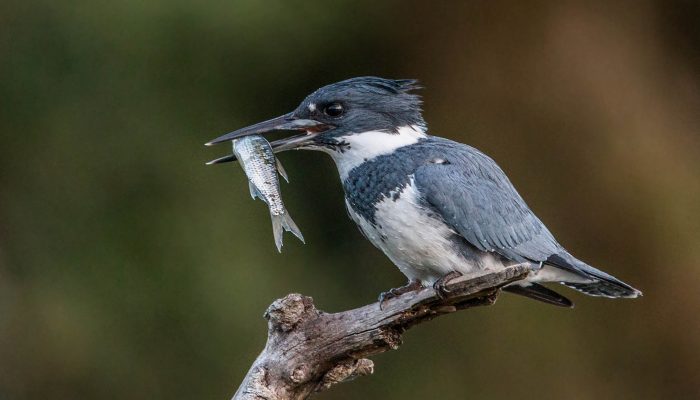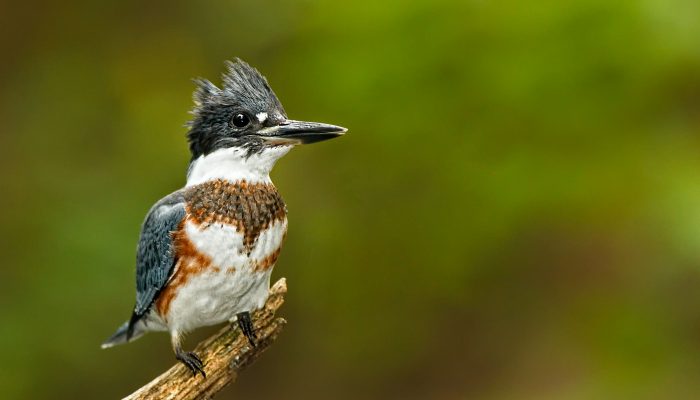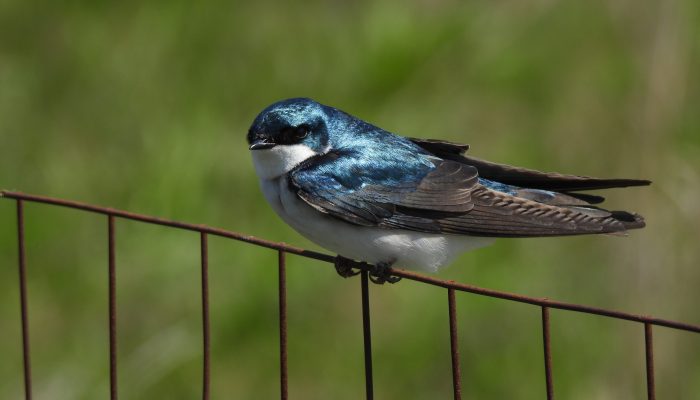The Belted Kingfisher is a unique bird found along creeks in our area. Here are some fun facts about this bird with ancient origins.
By Susan Haidar, Environmental Educator
Cobbs Creek Community Environmental Center
Have you ever heard a sudden, loud, chattering (or rattling) call while walking on a trail near one of Philadelphia’s creeks? If you do, look quickly towards the creek. See if you can spot a medium-sized bird flying rapidly over the water. If not, look again…is it perched on a branch overlooking the water?
You’ve spotted it…a large gray-blue bird with a stocky body; large, crested head; and a straight, sharp, thick beak! Wow! It sure looks a little out of “normal” proportions. This is the Belted Kingfisher. If you’ve found a female, look for the reddish-brown markings on her chest and lower body. She has more colors than the male, who is all blue-gray and white. This is the first unusual thing about this bird: males are typically more colorful. Although to me, the male’s gray color appears more brilliant.

Next, observe that sharp, spear-like beak. It is used for diving head-first into water and catching small fish or crayfish. The bird’s flight over water is rapid, but it may hover looking for a catch. It may also grab a frog, tadpole, or aquatic insect. One unusual characteristic is that adult birds cannot digest the bones of their prey. They regurgitate them as pellets, much like owls do. If we could walk along that bank, we’d probably find some of these pellets.
The Kingfisher’s nesting patterns are rather unique. The male and female birds take turns excavating a 3 to 6-foot tunnel in a soft, stream bank. The horizontal tunnel is dug angled upward and the bird builds a “room” at the end for nesting. The upward direction helps mitigate flooding. Finding the right nesting conditions can be challenging.
The Belted-Kingfisher is the only type of bird like it in most of the United States and Canada. There are two other types of Kingfishers in North America, primarily in Mexico. To find other Kingfisher species you’d have to visit Australia and tropical areas of Africa and Asia.
Interesting facts about the Belted Kingfisher:
-
Belted Kingfishers have two fused toes. Most birds have three forward-facing toes and one backward. The position of the toes helps scientists distinguish this order of birds from others.
-
Their relatives have unusual names: Bee-eaters, Rollers, Motmots, and Todies. Most Kingfishers and their relatives are beautifully colored birds.
-
Kingfishers have ancient relatives. Kingfisher fossils have been found that date to 2 million years ago.
-
The order of birds they belong to, the Coraciiforme, is even older. There are fossils that date to 35 million years ago!
Where to see them
Good places to look or listen for a Kingfisher include Cobbs Creek Park near Cobbs Creek Community Environmental Center and near Mt. Moriah Cemetery, Wissahickon Valley Park, Pennypack Park, and John Heinz National Wildlife refuge.




